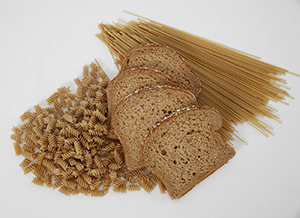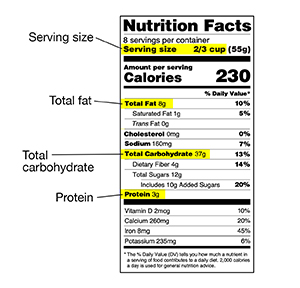Understanding Carbohydrates
Just like a car needs the right type of fuel to run, you need the right kind of food to function. To keep your energy level up, your body needs food that has carbohydrates (carbs). But carbs raise blood sugar levels higher and faster than other kinds of food. Your dietitian will work with you to figure out the amount of carbs you need. Carbs come in 3 types: starches, sugars, and fiber.
Starches
Starches are found in grains, some vegetables, and beans. Grain products include bread, pasta, cereal, and tortillas. Starchy vegetables include potatoes, peas, corn, lima beans, yams, and squash. Kidney beans, pinto beans, black beans, garbanzo beans, and lentils also have starches.

Sugars
Sugars are found naturally in many foods. Or they can be added. Foods that contain natural sugar include fruits and fruit juices, dairy products, honey, and molasses. Added sugars are found in most desserts, processed foods, candy, regular soda, and fruit drinks. These are very helpful to treat low blood sugar (hypoglycemia). They give you sugar quickly. Try to keep at least 15 to 20 grams of these simple sugars with you at all times. Eat or drink these if you start to have symptoms of low blood sugar.
Fiber
Fiber comes from plant foods. Your body can't digest most fiber. Instead of raising blood sugar levels like other carbs, fiber stops blood sugar from rising too quickly. Fiber is found in fruits, vegetables, whole grains, beans, peas, and many nuts.
Understanding how to count your carbs
Keep track of the amount of carbs you eat. This can help you keep the right balance of carbs, physical activity, and medicine. The amount of carbs you need will be different from what other people need. How much you need depends on many things. These include your health, the medicines you take, and how active you are. Your healthcare team will help you figure out the right amount of carbs for you. You may start with 45 to 60 grams of carbs per meal, depending on your case. Carb counting is a system that helps you keep track of the carbohydrates you eat at each meal.
Carbs come from many foods. These include grains, starchy vegetables, fruit, milk, beans, and snack foods. You can either count carbohydrate grams or carbohydrate servings. When you count carbohydrate servings, 1 carbohydrate serving = 15 grams of carbohydrates.
Here are some examples of foods that have about 15 grams of carbs (1 serving of carbohydrates):
-
1/2 cup of canned or frozen fruit
-
A small piece of fresh fruit (4 ounces)
-
1 slice of bread
-
1/2 cup of oatmeal
-
1/3 cup of rice
-
4 to 6 crackers
-
1/2 English muffin
-
1/2 cup of black beans
-
1/4 of a large baked potato (3 ounces)
-
2/3 cup of plain fat-free yogurt
-
1 cup of soup
-
1/2 cup of casserole
-
6 chicken nuggets
-
2-inch-square brownie or cake without frosting
-
2 small cookies
-
1/2 cup of ice cream or sherbet
Carb counting is easier when food labels are available. Look at the label to see how many grams of total carbs per serving the food contains. Then you can figure out how much you should eat. If your food doesn't have a nutrition label, you should be able to get an idea of how many carbs there are per serving by using a book or website.
Two very important lines to look at on the label are the serving size and the total carbohydrate amount per serving. Here are some tips for using food labels to count your carbs:
-
Check the serving size. The information on the label is based on that serving size. If you eat more than the listed serving size, you may have to double or triple the other information on the label.
-
Check the total grams of carbs. Total carbohydrate from the label includes sugar, starch, and fiber. Be sure to use the total carbohydrate number (minus the fiber) and not sugar alone.
-
Know how many grams of carbs you can have. Be familiar with the matching portion sizes.
-
Compare labels. Compare the labels of different products. Look at serving sizes and total carbs to find the products that work best for you.
-
Don't forget protein and fat. With the focus on carb counting, it might be easy to forget protein and fat in your meals. Don't forget to include sources of protein and healthy fat to balance your meals. Also watch how much salt (sodium) you eat. This is especially true if you have high blood pressure. If you have diabetes, limit the amount of sodium to less than 2,300 mg a day.

It’s also important to be consistent with the amount of carbs and time you eat when taking a fixed dose of diabetes medicine. Work with your healthcare provider or dietitian if you need more help. They can help you keep track of your carbs. They can also help you figure out how many grams of carbs you should have.